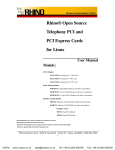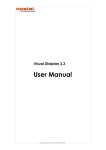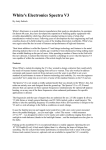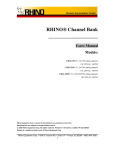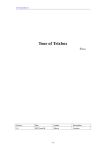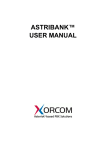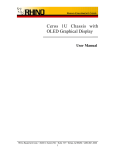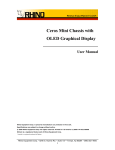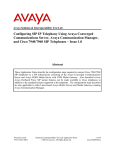Download RHINO R8FXX Specifications
Transcript
Rhino® Open Source Telephony PCI and PCI Express Cards for Linux User Manual Models: T1/E1 Models: •R1T1, R1T1e: Single port T1 PCI card •R2T1, R2T1e: Dual port T1 PCI card •R4T1, R4T1e: Quad port T1 PCI card Fixed Analog Models: •R4FXOEC: Quad FXO Channels with Echo Cancellation •R24FXSEC: 24 port FXS Channels with Echo Cancellation •R24FXOEC: 24 port FXO Channels with Echo Cancellation Modular Analog Models: •R8FXX: Modular Octal FXS/FXO with Echo Cancellation •R24FXX: Modular 24 FXS/FXO with Echo Cancellation Daughter cards: •DFXS: Dual FXS Module •DFXO: Dual FXO Module Rhino Equipment Corp. is proud to manufacture our products in the U.S.A. Specifications are subject to change without notice. © 2006, 2007 Rhino Equipment Corp. All rights reserved. Printed in U S America 4/2007 PN 03100006 Rhino® is a registered trade mark of Rhino Equipment Corp. Rhino Equipment Corp. • 8240 S. Kyrene Rd. • Suite 107 • Tempe, AZ 85284 • (480) 9401826 1 Managing your open source telecommunication needs has never been easier than with Rhino products. Rhino PCI plugin cards satisfy the needs of Open Source Telephony (OST) applications, no matter how stringent the requirement. Rhino Open Source Telephony PCI cards feature Asterisk* and Linux tested software. Knowing that Rhino products are ready to perform right out of the box means that you can spend more time developing important customer relationships. Rhino Equipment Corp. offers you a complete line of low cost PCI plugin cards including Single T1/E1, Dual T1/E1, Quad T1/E1, all three with optional echo cancellation using a plugin module, and our analog cards, the Quad FXO analog, Octal FXS/FXO modular, 24 port FXS/FXO modular, and the R24FXS and R24FXO fixed circuit analog interfaces, all with echo cancellation onboard. Also, don’t forget our full line of Rhino Channel Bank products, for largescale analog FXS or FXO applications. Thank you for purchasing a Rhino Open Source Telephony (OST) PCI card. For unparalleled performance and years of operation please follow the instructions provided in this user manual. Rhino designed products are tough. In the rare case of trouble, our technical support staff is ready to give you the support you need, when you need it. Our 5year, limited warranty means that you can be confident that Rhino will always work in your Open Source Telephony application. Rhino Equipment Corp. • 8240 S. Kyrene Rd. • Suite 107 • Tempe, AZ 85284 • (480) 9401826 2 * Asterisk is a registered trademark of Digium. Software License All Rhino OST PCI cards require Linux module software to operate. We distribute our software under the GNU General Public License, which is enclosed here for your review.(as obtained from http://www.gnu.org/copyleft/gpl.html) GNU GENERAL PUBLIC LICENSE Version 2, June 1991 Copyright (C) 1989, 1991 Free Software Foundation, Inc. 51 Franklin Street, Fifth Floor, Boston, MA 021101301, USA Everyone is permitted to copy and distribute verbatim copies of this license document, but changing it is not allowed. Preamble The licenses for most software are designed to take away your freedom to share and change it. By contrast, the GNU General Public License is intended to guarantee your freedom to share and change free softwareto make sure the software is free for all its users. This General Public License applies to most of the Free Software Foundation's software and to any other program whose authors commit to using it. (Some other Free Software Foundation software is covered by the GNU Lesser General Public License instead.) You can apply it to your programs, too. When we speak of free software, we are referring to freedom, not price. Our General Public Licenses are designed to make sure that you have the freedom to distribute copies of free software (and charge for this service if you wish), that you receive source code or can get it if you want it, that you can change the software or use pieces of it in new free programs; and that you know you can do these things. To protect your rights, we need to make restrictions that forbid anyone to deny you these rights or to ask you to surrender the rights. These restrictions translate to certain responsibilities for you if you distribute copies of the software, or if you modify it. For example, if you distribute copies of such a program, whether gratis or for a fee, you must give the recipients all the rights that you have. You must make sure that they, too, receive or can get the source code. And you must show them these terms so they know their rights. We protect your rights with two steps: (1) copyright the software, and (2) offer you this license which gives you legal permission to copy, distribute and/or modify the software. Also, for each author's protection and ours, we want to make certain that everyone understands that there is no warranty for this free software. If the software is modified by someone else and passed on, we want its recipients to know that what they have is not the original, so that any problems introduced by others will not reflect on the original authors' reputations. Finally, any free program is threatened constantly by software patents. We wish to avoid the danger that redistributors of a free program will individually obtain patent licenses, in effect making the program proprietary. To prevent this, we have made it clear that any patent must be licensed for everyone's free use or not licensed at all. The precise terms and conditions for copying, distribution and modification follow. TERMS AND CONDITIONS FOR COPYING, DISTRIBUTION AND MODIFICATION 0. This License applies to any program or other work which contains a notice placed by the copyright holder saying it may be distributed under the terms of this General Public License. The "Program", below, refers to any such program or work, and a "work based on the Program" means either the Program or any derivative work under copyright law: that is to say, a work containing the Program or a portion of it, either verbatim or with modifications and/or translated into another language. (Hereinafter, translation is included without limitation in the term "modification".) Each licensee is addressed as "you". Rhino Equipment Corp. • 8240 S. Kyrene Rd. • Suite 107 • Tempe, AZ 85284 • (480) 9401826 3 Activities other than copying, distribution and modification are not covered by this License; they are outside its scope. The act of running the Program is not restricted, and the output from the Program is covered only if its contents constitute a work based on the Program (independent of having been made by running the Program). Whether that is true depends on what the Program does. 1. You may copy and distribute verbatim copies of the Program's source code as you receive it, in any medium, provided that you conspicuously and appropriately publish on each copy an appropriate copyright notice and disclaimer of warranty; keep intact all the notices that refer to this License and to the absence of any warranty; and give any other recipients of the Program a copy of this License along with the Program. You may charge a fee for the physical act of transferring a copy, and you may at your option offer warranty protection in exchange for a fee. 2. You may modify your copy or copies of the Program or any portion of it, thus forming a work based on the Program, and copy and distribute such modifications or work under the terms of Section 1 above, provided that you also meet all of these conditions: a) You must cause the modified files to carry prominent notices stating that you changed the files and the date of any change. b) You must cause any work that you distribute or publish, that in whole or in part contains or is derived from the Program or any part thereof, to be licensed as a whole at no charge to all third parties under the terms of this License. c) If the modified program normally reads commands interactively when run, you must cause it, when started running for such interactive use in the most ordinary way, to print or display an announcement including an appropriate copyright notice and a notice that there is no warranty (or else, saying that you provide a warranty) and that users may redistribute the program under these conditions, and telling the user how to view a copy of this License. (Exception: if the Program itself is interactive but does not normally print such an announcement, your work based on the Program is not required to print an announcement.) These requirements apply to the modified work as a whole. If identifiable sections of that work are not derived from the Program, and can be reasonably considered independent and separate works in themselves, then this License, and its terms, do not apply to those sections when you distribute them as separate works. But when you distribute the same sections as part of a whole which is a work based on the Program, the distribution of the whole must be on the terms of this License, whose permissions for other licensees extend to the entire whole, and thus to each and every part regardless of who wrote it. Thus, it is not the intent of this section to claim rights or contest your rights to work written entirely by you; rather, the intent is to exercise the right to control the distribution of derivative or collective works based on the Program. In addition, mere aggregation of another work not based on the Program with the Program (or with a work based on the Program) on a volume of a storage or distribution medium does not bring the other work under the scope of this License. 3. You may copy and distribute the Program (or a work based on it, under Section 2) in object code or executable form under the terms of Sections 1 and 2 above provided that you also do one of the following: a) Accompany it with the complete corresponding machinereadable source code, which must be distributed under the terms of Sections 1 and 2 above on a medium customarily used for software interchange; or, b) Accompany it with a written offer, valid for at least three years, to give any third party, for a charge no more than your cost of physically performing source distribution, a complete machinereadable copy of the corresponding source code, to be distributed under the terms of Sections 1 and 2 above on a medium customarily used for software interchange; or, c) Accompany it with the information you received as to the offer to distribute corresponding source code. (This alternative is allowed only for noncommercial distribution and only if you received the program in object code or executable form with such an offer, in accord with Subsection b above.) The source code for a work means the preferred form of the work for making modifications to it. For an executable work, complete source code means all the source code for all modules it contains, plus any associated interface definition files, plus the scripts used to control compilation and installation of the executable. However, as a special exception, the source code distributed need not include anything that is normally distributed (in either source or binary form) with the major components (compiler, kernel, and so on) of the operating system on which the executable runs, unless that component itself accompanies the executable. If distribution of executable or object code is made by offering access to copy from a designated place, then offering equivalent access to copy the source code from the same place counts as distribution of the source code, even though third parties are not compelled to copy the source along with the object code. 4. You may not copy, modify, sublicense, or distribute the Program except as expressly provided under this License. Any attempt otherwise to copy, modify, sublicense or distribute the Program is void, and will automatically terminate your rights under this License. However, parties who have received copies, or rights, from you under this License will not have their licenses terminated so long as such parties remain in full compliance. Rhino Equipment Corp. • 8240 S. Kyrene Rd. • Suite 107 • Tempe, AZ 85284 • (480) 9401826 4 5. You are not required to accept this License, since you have not signed it. However, nothing else grants you permission to modify or distribute the Program or its derivative works. These actions are prohibited by law if you do not accept this License. Therefore, by modifying or distributing the Program (or any work based on the Program), you indicate your acceptance of this License to do so, and all its terms and conditions for copying, distributing or modifying the Program or works based on it. 6. Each time you redistribute the Program (or any work based on the Program), the recipient automatically receives a license from the original licensor to copy, distribute or modify the Program subject to these terms and conditions. You may not impose any further restrictions on the recipients' exercise of the rights granted herein. You are not responsible for enforcing compliance by third parties to this License. 7. If, as a consequence of a court judgment or allegation of patent infringement or for any other reason (not limited to patent issues), conditions are imposed on you (whether by court order, agreement or otherwise) that contradict the conditions of this License, they do not excuse you from the conditions of this License. If you cannot distribute so as to satisfy simultaneously your obligations under this License and any other pertinent obligations, then as a consequence you may not distribute the Program at all. For example, if a patent license would not permit royaltyfree redistribution of the Program by all those who receive copies directly or indirectly through you, then the only way you could satisfy both it and this License would be to refrain entirely from distribution of the Program. If any portion of this section is held invalid or unenforceable under any particular circumstance, the balance of the section is intended to apply and the section as a whole is intended to apply in other circumstances. It is not the purpose of this section to induce you to infringe any patents or other property right claims or to contest validity of any such claims; this section has the sole purpose of protecting the integrity of the free software distribution system, which is implemented by public license practices. Many people have made generous contributions to the wide range of software distributed through that system in reliance on consistent application of that system; it is up to the author/donor to decide if he or she is willing to distribute software through any other system and a licensee cannot impose that choice. This section is intended to make thoroughly clear what is believed to be a consequence of the rest of this License. 8. If the distribution and/or use of the Program is restricted in certain countries either by patents or by copyrighted interfaces, the original copyright holder who places the Program under this License may add an explicit geographical distribution limitation excluding those countries, so that distribution is permitted only in or among countries not thus excluded. In such case, this License incorporates the limitation as if written in the body of this License. 9. The Free Software Foundation may publish revised and/or new versions of the General Public License from time to time. Such new versions will be similar in spirit to the present version, but may differ in detail to address new problems or concerns. Each version is given a distinguishing version number. If the Program specifies a version number of this License which applies to it and "any later version", you have the option of following the terms and conditions either of that version or of any later version published by the Free Software Foundation. If the Program does not specify a version number of this License, you may choose any version ever published by the Free Software Foundation. 10. If you wish to incorporate parts of the Program into other free programs whose distribution conditions are different, write to the author to ask for permission. For software which is copyrighted by the Free Software Foundation, write to the Free Software Foundation; we sometimes make exceptions for this. Our decision will be guided by the two goals of preserving the free status of all derivatives of our free software and of promoting the sharing and reuse of software generally. NO WARRANTY 11. BECAUSE THE PROGRAM IS LICENSED FREE OF CHARGE, THERE IS NO WARRANTY FOR THE PROGRAM, TO THE EXTENT PERMITTED BY APPLICABLE LAW. EXCEPT WHEN OTHERWISE STATED IN WRITING THE COPYRIGHT HOLDERS AND/OR OTHER PARTIES PROVIDE THE PROGRAM "AS IS" WITHOUT WARRANTY OF ANY KIND, EITHER EXPRESSED OR IMPLIED, INCLUDING, BUT NOT LIMITED TO, THE IMPLIED WARRANTIES OF MERCHANTABILITY AND FITNESS FOR A PARTICULAR PURPOSE. THE ENTIRE RISK AS TO THE QUALITY AND PERFORMANCE OF THE PROGRAM IS WITH YOU. SHOULD THE PROGRAM PROVE DEFECTIVE, YOU ASSUME THE COST OF ALL NECESSARY SERVICING, REPAIR OR CORRECTION. 12. IN NO EVENT UNLESS REQUIRED BY APPLICABLE LAW OR AGREED TO IN WRITING WILL ANY COPYRIGHT HOLDER, OR ANY OTHER PARTY WHO MAY MODIFY AND/OR REDISTRIBUTE THE PROGRAM AS PERMITTED ABOVE, BE LIABLE TO YOU FOR DAMAGES, INCLUDING ANY GENERAL, SPECIAL, INCIDENTAL OR CONSEQUENTIAL DAMAGES ARISING OUT OF THE USE OR INABILITY TO USE THE PROGRAM (INCLUDING BUT NOT LIMITED TO LOSS OF DATA OR DATA BEING RENDERED INACCURATE OR LOSSES SUSTAINED BY YOU OR THIRD PARTIES OR A FAILURE OF THE PROGRAM TO OPERATE WITH ANY OTHER PROGRAMS), EVEN IF SUCH HOLDER OR OTHER PARTY HAS BEEN ADVISED OF THE POSSIBILITY OF SUCH DAMAGES. Rhino Equipment Corp. • 8240 S. Kyrene Rd. • Suite 107 • Tempe, AZ 85284 • (480) 9401826 5 User Information for FCC Part 68 Products: R1T1, R1T1e, R2T1, R3T1e, R4T1, R4T1e, R4FXO, R8FXX, R24FXX, R24FXS, and R24FXO models This equipment complies with Part 68 of the FCC rules and the requirements adopted by the ACTA. On the bottom of this equipment is a label that contains, among other information, a product identifier in the format US: AAAEQ##TXXXX (where “X’s” are shown will represent product number, for example R1T1). If requested, this number must be provided to the telephone company. This equipment uses the standard RJ11C, RJ21 or RJ48C jack types for network connection. A plug and jack used to connect this equipment to the premises wiring and telephone network must comply with the applicable FCC Part 68 rules and requirements adopted by the ACTA. A compliant telephone cord and modular plug is provided with this product. It is designed to be connected to a compatible modular jack that is also compliant. See installation instructions for details. If this equipment causes harm to the telephone network, the telephone company will notify you in advance that temporary discontinuance of service may be required. But if advance notice isn’t practical, the telephone company will notify the customer as soon as possible. Also, you will be advised of your right to file a complaint with the FCC if you believe it is necessary. The telephone company may make changes in its facilities, equipment, operations or procedures that could affect the operation of the equipment. If this happens the telephone company will provide advance notice in order for you to make necessary modifications to maintain uninterrupted service. If trouble is experienced with this equipment, for repair or warranty information, please contact Rhino Equipment Corp, 8240 S. Kyrene Road, Suite 107, Tempe, AZ 85284. Tel: 800.785.7073. If the equipment is causing harm to the telephone network, the telephone company may request that you disconnect the equipment until the problem is resolved. Connection to party line service is subject to state tariffs. Contact the state public utility commission, public service commission or corporation commission for information. If your home has specially wired alarm equipment connected to the telephone line, ensure the installation of this equipment does not disable your alarm equipment. If you have questions about what will disable alarm equipment, consult your telephone company or a qualified installer. Rhino Equipment Corp. • 8240 S. Kyrene Rd. • Suite 107 • Tempe, AZ 85284 • (480) 9401826 6 User Information for FCC Part 15 THIS DEVICE COMPLIES WITH PART 15 OF THE FCC RULES. OPERATION IS SUBJECT TO THE FOLLOWING TWO CONDITIONS: 1(1) THIS DEVICE MAY NOT CAUSE HARMFUL INTERFERENCE, AND 2(2) THIS DEVICE MUST ACCEPT ANY INTERFERENCE, RECEIVED, INCLUDING INTERFERENCE THAT MAY CAUSE UNDESIRED OPERATION. NOTE: This equipment has been tested and found to comply with the limits for a Class B digital device, pursuant to part 15 of the FCC Rules. These limits are designed to provide reasonable protection against harmful interference in a residential installation. This equipment generates, uses and can radiate radio frequency energy and, if not installed and used in accordance with the instructions, may cause harmful interference to radio communications. However, there is no guarantee that interference will not occur in a particular installation. If this equipment does cause harmful interference to radio or television reception, which can be determined by turning the equipment off and on, the user is encouraged to try to correct the interference by one or more of the following measures: Reorient or relocate the receiving antenna. Increase the separation between the equipment and receiver. Connect the equipment into an outlet on a circuit different from that to which the receiver is connected. Consult the dealer or an experienced radio/TV technician for help. NOTE: RHINO EQUIPMENT CORP. IS NOT RESPONSIBLE FOR ANY RADIO OR TV INTERFERENCE CAUSED BY UNAUTHORIZED MODIFICATIONS TO THIS EQUIPMENT. SUCH MODIFICATIONS COULD VOID THE USER'S AUTHORITY TO OPERATE THE EQUIPMENT. Rhino Equipment Corp. • 8240 S. Kyrene Rd. • Suite 107 • Tempe, AZ 85284 • (480) 9401826 7 This page intentionally left blank. Rhino Equipment Corp. • 8240 S. Kyrene Rd. • Suite 107 • Tempe, AZ 85284 • (480) 9401826 8 Table of Contents: Rhino® Open Source Telephony PCI and PCI Express Cards .......................................................................................................................................1 for Linux.........................................................................................................................................................1 Software License............................................................................................................................................3 Products: R1T1, R1T1e, R2T1, R3T1e, R4T1, R4T1e, R4FXO, R8FXX, R24FXX, R24FXS, and R24FXO models..............................................................................................................................................7 1. PREINSTALLATION ........................................................................................................................11 1.a Warranty 11 1.b Standards 11 1.c Surge Protection 12 2. INSTALLATION ...................................................................................................................................13 2.a Site Selection 13 2.b Unpacking the Rhino PCI Card 13 2.c Physical Installation 14 3. INSTALLATION FOR T1 OST CARDS............................................................................................. 15 3.a Connecting the Rhino T1 Card to T1/E1/PRI 15 Fig 2....................................................................................................................................15 3.b Hardware Configuration 17 4. INSTALLATION FOR Rhino OST Analog CARDS ...........................................................................24 4.a Connecting Rhino Analog cards to telco/extensions. 24 4.c Rhino OST PCI Analog card Channel configurations 26 4.e Rhino Firmware File Update 26 4.f Connecting Power to the Rhino R8FXX, R24FXX, and R24FXS Analog card installations 28 4.g Rhino R4FXO (Rev. C and higher) and R8FXX LED Codes 30 Rhino Equipment Corp. • 8240 S. Kyrene Rd. • Suite 107 • Tempe, AZ 85284 • (480) 9401826 9 1. PREINSTALLATION Rhino OST PCI cards are easy to setup and use, which will make your telephony life easier! Please spend a few minutes reviewing these instructions to ensure a successful installation. 1.a Warranty Rhino OST PCI cards are covered by a 5year limited factory warranty. The warranty statement is available on the Rhino web site, the Rhino CDROM, the Rhino Public FTP, or by request. Please note that damage caused by improper installation or acts of nature are not covered by this warranty. 1.b Standards This equipment complies with Part 68 of the FCC Rules. The number is located on the back of the Rhino OST PCI Card. The label contains the FCC Registration Number for this equipment. If requested, this information must be presented to your telephone company. Connection to the telephone network should be made by using standard modular network jacks, type RJ45. The plug and/or jacks used must comply with FCC Part 68 Rules. OPERATION FIC SOC (USOC) JACK T1 CSU Interface 04DU9BN 6.0N RJ48C 04DU9DN 04DU91KN 04DU91SN If this telephone equipment causes harm to the telephone network, the telephone company will notify you in advance that temporary discontinuance of service may be required. But if advance notice isn’t practical, the telephone company will notify the customer as soon as possible. Also, you will be advised of your right to file a complaint with the FCC if you believe it is necessary. The telephone company may make changes in its facilities, equipment, operations or procedures that could affect the proper functioning of your equipment. If they do, you will be notified in advance in order for you to make necessary modifications to maintain uninterrupted service. If trouble is experienced with this unit, please contact customer service at the address and phone listed below. DO NOT DISASSEMBLE THIS EQUIPMENT. It does not contain any user serviceable components. 1.c Surge Protection It is recommended that a surge protector or uninterruptible power supply (UPS) be installed in conjunction with the PC that the Rhino OST PCI card is installed in. This will help minimize damage as a result of lightning strikes and other AC line surges. Failure to use a UPS could affect the 5 year limited warranty. Rhino Equipment Corp. • 8240 S. Kyrene Rd. • Suite 107 • Tempe, AZ 85284 • (480) 9401826 10 2. INSTALLATION 2.a Site Selection The selected installation site should provide a stable operating environment. The area around the installation site should be clean and free from extremes of temperature, humidity, shock, and vibration. The operating temperature should be kept below 100 degrees F (38° C). The Rhino OST PCI card is designed to be used on T1/DS1/ISDNPRI/E1 services for a T1 card, or to be connected to the PSTN when using and analog card. Connecting it to any other type of telecommunications service or services will void the warranty and could cause damage to the network of the provider of the nonapproved service or services. All wiring done external to the Rhino OST PCI card should follow the guidelines as set forth by the National Electrical Code. See section 1.b and 3.a. 2.b Unpacking the Rhino PCI Card The unit comes tested and sealed in an antistatic custom shipping box. The package contains the Rhino OST PCI card Users Manual, and a Rhino Products CD containing the most recent drivers and documentation. Before removing the card from its packaging, ensure that you are grounded. To ground yourself please use an AntiStatic wrist band. Inspect the Rhino OST PCI card for any signs of physical damage. Report any damages to the shipper. Keep all packaging material in the event that you need to move or ship the unit. Warranty returns must be shipped back to Rhino Equipment Corp in the original shipping box. Rhino Equipment Corp. • 8240 S. Kyrene Rd. • Suite 107 • Tempe, AZ 85284 • (480) 9401826 11 2.c Physical Installation Before removing the card from its packaging, ensure that you are grounded. To ground yourself please use an AntiStatic wrist band. While removing the Rhino OST PCI card take care to only handle the mounting bracket, avoid making contact with any of the PCI card circuitry. The Rhino OST PCI card is intended to be installed in an ATX form factor motherboard, the chassis housing the Rhino OST PCI card should also be an ATX form factor chassis. Failure to install the Rhino OST PCI card in this configuration will affect the warranty of your Rhino product(s). Fig 1. Rhino Equipment Corp. • 8240 S. Kyrene Rd. • Suite 107 • Tempe, AZ 85284 • (480) 9401826 12 3. INSTALLATION FOR T1 OST CARDS 3.a Connecting the Rhino T1 Card to T1/E1/PRI The Rhino OST T1 cards (DS1) interface is an industrystandard RJ48C eight pin connector with its connections described below. The T1 is usually connected to a Rhino CB24 channel bank or the telecommunications carrier demarcation point. If the T1 is coming from a Rhino CB24 channel bank, the T1 cable must be a crossover T1 cable. Figure 2 shows the pin out for building a T1 crossover cable. This cable can be used to connect two T1 CSU/DSU (i.e. TSU) products in a pointtopoint configuration. Fig 2. Rhino Equipment Corp. • 8240 S. Kyrene Rd. • Suite 107 • Tempe, AZ 85284 • (480) 9401826 13 If the T1 is coming from the demarcation point please use a straight thru T1 cable to connect to the Rhino OST T1 card. In some cases additional cable must be run from the carrier’s demarcation point to the customer’s suite or nearby “phone room”. T1 Line Interface on RJ45 8 pin Modular T1 jack Pin Number 1 2 3 4 5 6 7 8 Signal Receive Ring Receive Tip Not connected Transmit Ring Transmit Tip Not connected Not connected Not connected To/From What? Coming From T1 (Network) Coming From T1 (Network) Going To T1 (Network) Going To T1 (Network) The maximum cable length for a T1 Network (DS11) connection is suggested as follows. Reliable T1 cabling distances depend on which type of cable is used. It is strongly recommended that only shielded cable be used as part of any T1 installation. For best results use: shielded 22 AWG T1 cable (ABAM 600). ABAM 600 T1 Cable T1 Network (CSU) can go as far as 6,000 feet ABAM 600 Cable Specifications: Nominal Impedance: 100 ohms +/ 5% at 772 kHz. Insertion Loss: Better than 7 dB per 1,000 feet at 1.544 MHz. Better than 5 dB per 1,000 feet at 772 kHz. Better than 85 dB per 1,000 feet at 1.544 MHz. Better than 90 dB per 1,000 feet at 772 kHz. Better than 80 dB per 1,000 feet at 1.544 MHz. Better than 85 dB per 1,000 feet at 772 kHz. Transmit and receive pairs are individually shielded with aluminum/polyester tape. FarEnd Crosstalk: NearEnd Crosstalk: Shields: If you used unshielded cable you could experience problems. When this type of cable is used, transmit and receive pairs are usually run in separate cables to avoid crosstalk which often occurs in unshielded cables. Failure to use separate cable bundles for transmit and receive can result in the CSU LINE port clocking onto itself (due to crosstalk) with as little as 10 feet of unterminated (unshielded) telephone cable attached. The CSU can thus show a normal framed status when the far end of the telephone wiring is actually disconnected. Again, this is due to crosstalk between pairs in the same cable bundle. This is true of any CSU installation using any kind of unshielded twisted pair cable. Rhino Equipment Corp. • 8240 S. Kyrene Rd. • Suite 107 • Tempe, AZ 85284 • (480) 9401826 14 3.b Hardware Configuration Fig 3 Normally, no other configuration is necessary to get a Rhino digital telephony card to operate in a system. In cases where multiple cards are used within the same system, or mixed E1 and T1 modes are needed on the same card, additional configuration may be necessary. Timing Cable A special 20 pin ribbon cable can be used to connect multiple Rhino digital telephony cards to provide a common clocking source to all spans. In Fig. 3, box 1 shows the location of the Timing cable connector. Obtain this cable direct from Rhino by contacting Technical Support. Please note that special command line options must be provided when loading the module to allow for this option to operate as planned. T1/E1 Span Selector In cases where all cards of the same type are not configured the same; or when enabling E1 (T1 is the default configuration). The span selector pin header can be used to select the desired mode for each span. In Fig. 3, box 2, the span type selection can be made by installing a shorting midgie across the span where E1 is desired. There are two options for this situation: NOTE: r1t1 is the module for the Rhino R1T1 PCI Cards. The rxt1 module is for the R2T1 and R4T1 Cards. By using insmod, or putting the parameter in modprobe.conf (or a file in the directory /etc/modules.d/ depending on the distribution). Bit 0 of xx is a 0 to configure span 1 as a T1 or a 1 to configure span 1 as E1. Bit 1 configures span2 etc. Example: t1e1 = 3 configures span 1 as E1, span 2 as E1, span 3 as T1, and span 4 as T1. All installed cards will have the same configuration. The line looks like: insmod rxt1.ko t1=xx To make your Rhino T1 to a Rhino E1: R1T1 E1 configuration: insmod /lib/modules/`uname r`/extra/r1t1.ko e1=1 (OR e1t1override=1) Rhino Equipment Corp. • 8240 S. Kyrene Rd. • Suite 107 • Tempe, AZ 85284 • (480) 9401826 15 R2T1 and R4T1 E1 Configuration: insmod /lib/modules/`uname r`/extra/rxt1.ko t1e1override=15 (if this does not work try: insmod /lib/modules/`uname r`/extra/rxt1.ko e1=15) Load Identifier (Module Instance Load order) Normally Linux loads PCI devices in the order that they are found on the PCI bus, most likely from the PCI slot closest to the CPU on the motherboard, and outward from that position. For a digital telephony card, slot 1 would become the first span loaded, and would default to Span 1 in all configurations. The Load rotary switch allows for alternate loading of the position of the PCI card, and allows for spans to be loaded in a different order than how the cards are located in the motherboard. 3.c Generic Instructions for Installing ALL Rhino PCI cards. OS and Zaptel agnostic. Note: TRIXBOX 2.2 users. Please follow the directions at the end of the installation section. Note: The Rhino drivers (module) are only compatible with the Linux kernel 2.6.9 and higher. Please make sure this is installed and the Rhino OST PCI card is properly installed before continuing with the software configuration. 1. Boot the PC and log in as “root” or other user that has appropriate software build privileges. 2. Navigate to the Zaptel source directory. This is normally located in: “/usr/src/zaptel”. If the Zaptel source is not present, you will need to download that using the next sections. If the Zaptel directory is already present, you may jump to number 10 below. Note: The zaptel source directory can be anywhere on your hard drive, you will need to locate where you installed zaptel if the above example does not work for you. However if the zaptel directory is anything other than “/usr/src/zaptel” then create a link that points to the actual Zaptel source directory. Zaptel Source Installation Notes (only if needed, these optional steps are shown with a >x below, items 3 through 9 below): Note: For Trixbox 2.x users the Zaptel source and kernelheaders must be downloaded. If you are using Trixbox 2.x you need to download the Zaptel source, and recompile Zaptel. In the “/usr/src” directory (cd /usr/src) please install zaptel: >3. Download the Zaptel source, making sure that you are in the /usr/src directory: wget ftp.digium.com/pub/telephony/zaptel/releases/zaptelversion.number.tar.gz >4. Decompress the downloaded tarball tar xzvf zaptelversion.number.tar.gz >5. Create a symbolic link to zaptel: Rhino Equipment Corp. • 8240 S. Kyrene Rd. • Suite 107 • Tempe, AZ 85284 • (480) 9401826 16 ln s /usr/src/zaptelversion.number.tar.gz /usr/src/zaptel >6. Change your present working directory to /usr/src/zaptel cd /usr/src/zaptel >9. Compile Zaptel make && make install 10. In the “/usr/src/” directory please do the following ONLY IF your zaptel directory is different than “/usr/src/zaptel”: ln s /usr/src/zaptelxxx /usr/src/zaptel (where”/usr/src/zaptelxxx” is the path of your installed zaptel directory.) 11. Download the Rhino drivers in a single package: wget ftp://ftp.rhinoequipment.com/Drivers/rhinoversion#.tbz2 12. Extract the .tbz2 file to its own directory tar xjvf rhinoversion#.tbz2 13. Next change the directory into the Rhino Driver Directory, and run “make” as follows: make && make install (This will make and install the Rhino drivers independently of Zaptel and Asterisk. You may optionally use make, then make install to perform this in two separate command line sessions) 14. Next type the following command in the prompt to update the driver database: depmod 15. Now load your module. Depending on your card(s) type one of the following commands. For R4FXO rev A and B type: modprobe r4fxo For R4FXO rev C, R8FXX, R24FXX, R24FXS, and R24FXO type: modprobe rcbfx For R1T1 type: modprobe r1t1 Rhino Equipment Corp. • 8240 S. Kyrene Rd. • Suite 107 • Tempe, AZ 85284 • (480) 9401826 17 For R2T1, and R4T1 type: modprobe rxt1 16. Move on to configuring the zaptel interface. For more information on span and channel configuration please refer to sections 3.d & 3.e. For configuration examples for Rhino analog PCI cards please refer to section 4.c For TrixBox Specific Installations: 1. Boot the PC and log in as “root” or other user that has appropriate software build privileges. 2. Install the Rhino RPM's: yum y install rhino`uname r` press ENTER 3. reboot Note: genzaptelconf ONLY works in Trixbox 2.2 and later. 4. Type the following for analog cards: genzaptelconf For Digital Cards please skip to configuring zaptel.conf and zapata.conf Rhino Equipment Corp. • 8240 S. Kyrene Rd. • Suite 107 • Tempe, AZ 85284 • (480) 9401826 18 3.d Rhino OST T1/E1 PCI card Port and Span configurations The first lines of the zaptel configuration file (comments excluded) will be the span definitions for T1/E1 interfaces. A span definition is in this format: span=(spannum),(timing),(LBO),(framing),(coding) (see next page for more examples) Spannum: Spannum defines the number assigned to the span these definitions apply to. If you only have one R1T1 card installed you will only have one span (span 1), if there are two single port R1T1 cards installed you will have two spans (span 1 corresponds to the first port on the first module loaded). For an example of span numbering please refer to figure 3. Fig 4. (dimensions in inches) Timing: Use '1' if you want to use the circuit as your primary timing source. If '0' is used Asterisk will try to provide timing to the span (if you were connecting to a Rhino CB24 this would be correct.). If Asterisk is connected directly to the telco you will want to use '1' to accept timing from them. If you have multiple spans; set the timing accordingly such as 2, 3, 4, etc. 0: to not use this span as sync source 1: to use as primary sync source 2: to set as secondary and so forth Rhino Equipment Corp. • 8240 S. Kyrene Rd. • Suite 107 • Tempe, AZ 85284 • (480) 9401826 19 Tip: Problems with timing manifest themselves in different ways with static, pops, and channels or calls regularly dropping. LBO: Line Build Out (LBO) is taken from the table below. 0: 0 db (CSU) / 0133 feet (DSX1) 1: 133266 feet (DSX1) 2: 266399 feet (DSX1) 3: 399533 feet (DSX1) 4: 533655 feet (DSX1) 5: 7.5db (CSU) 6: 15db (CSU) 7: 22.5db (CSU) Framing: For T1 Framing is either d4 or esf. Coding is either ami or b8zs. For E1 – Framing is either cas or ccs. Coding is either ami or hdb3. E1’s spans may also need to enable crc checking. T1 span configuration used to connect to a Rhino CB24: span=1,0,0,esf,b8zs A common E1 span configuration: span=1,0,0,cas,ami,crc4 Leave off the ‘,crc4’ if crc checking should not be enabled. 3.e Rhino OST T1/E1 PCI card Channel configurations Rule of Thumb: Have you ever heard someone say “Opposites attract”? The same is true when configuring zaptel and Zapata for your Rhino OST PCI card. When configuring the signaling for your interface channels remember that physical FXO channels require FXS signaling and physical FXS channels require FXO signaling. When you are configuring your Rhino OST PCI T1 card to work with a Rhino CB24 please use the following signaling: (CB24FXO) signaling = fxsks(zaptel.conf) fxs_ks(zapata.conf) (CB24FXS) signaling = fxols(zaptel.conf) fxo_ls(zapata.conf) For CB24MOD signaling see the example below Rhino Equipment Corp. • 8240 S. Kyrene Rd. • Suite 107 • Tempe, AZ 85284 • (480) 9401826 20 zaptel.conf ;Span 1 span=1,0,0,esf,b8zs ; First 4 channels are the FXO modular card fxsks=14 ; Next 16 channels are the 4 modular FXS cards fxols=520 zapata.conf ;First 4 channels are the FXO modular card signalling = fxs_ks channel => 14 ;Next 16 channels are the 4 modular FXS cards signalling = fxo_ks channel => 520 Once zaptel.conf and zapata.conf are configured, initialize the card with the new configuration values by running “ztcfg” from the Linux command prompt. Tip: After configuring the signaling for your Rhino OST PCI card, start Asterisk in a terminal, then simply run “Auto T1” on your Rhino CB24 or manually configure it with LOOP signaling ESF framing and B8ZS coding. 3.f Rhino OST T1/E1 PCI card LED Status Codes Below is a chart for LED state code for all Rhino OST PCI T1/E1 cards: GREEN RED STATE On On On 2 Fast 2 Fast On 2 Fast 4 Fast 4 Fast Off Self Power Check PCI Slot Recognition Registering PCI Card With BIOS Loading Firmware Module Synchronizing With System Bus Hardware Software Off Off No Cable Link Detected Off On Invalid Carrier Signal 2 Fade On Module Loaded But Not configured On Off Normal Operation 2 Fade 2 Fade Yellow Alarm, Down Stream Sending Error Signal 2 Fade 4 Fast Sending Loop Back Signal 4 Fast 2 Fade Receiving Loop Back Signal 4 Fast 4 Fast Recovering Note: You will see most blink codes on a normal boot up, however if the card halts at any state this could indicate a problem. Rhino Equipment Corp. • 8240 S. Kyrene Rd. • Suite 107 • Tempe, AZ 85284 • (480) 9401826 21 4. INSTALLATION FOR Rhino OST Analog CARDS 4.a Connecting Rhino Analog cards to telco/extensions. The Rhino OST PCI analog cards use an industry standard RJ11 four pin plug for the R4FXO quad port FXO card, with pin lay out shown below. And an industry standard RJ14 four pin plug for all octal modular cards (R8FXX), pin lay out is also shown below. Phone Line Interface on RJ11 4 pin Modular jack: Pin Number 1 2 3 4 Signal Not connected Line Ring Line Tip Not connected To/From What? RX Coming From PSTN (CO) TX Going to PSTN (CO) Phone Line Interface on RJ14 4 pin Modular jack: Pin Number Signal To/From What? 1 Line 2 Tip TX Going to PSTN (CO) 2 Line 1 Ring RX Coming From PSTN (CO) 3 Line 1 Tip TX Going to PSTN (CO) 4 Line 2 Ring RX Coming From PSTN (CO) The 24 FXS channel (R24FXS) and modular 24 channel Rhino OST PCI (R24XX) analog cards uses an industry standard RJ21 connection, shown below. Rhino Equipment Corp. • 8240 S. Kyrene Rd. • Suite 107 • Tempe, AZ 85284 • (480) 9401826 22 Rhino Equipment Corp. • 8240 S. Kyrene Rd. • Suite 107 • Tempe, AZ 85284 • (480) 9401826 23 4.c Rhino OST PCI Analog card Channel configurations Rule of Thumb: Have you ever heard someone say “Opposites attract”? The same is true when configuring Zaptel and Zapata for your Rhino OST PCI card. When configuring the signaling for your interface channels remember that physical FXO channels require FXS signaling and physical FXS channels require FXO signaling. Rhino analog cards like LOOP and KEWL start signaling, so be sure to use just these two signaling choices in your Zaptel and Zapata configuration files! When you are configuring your Rhino OST PCI analog card with only FXO channels use the following signaling: zaptel.conf ; First 4 channels are the R4FXO card fxsks=14 ; Next 4 channels are the R8FXX card with two dual FXO modules installed fxsks=58 ;Next 4 channels are the R8FXX card with two dual FXS modules installed fxols=912 zapata.conf echocancel=yes (this must be specified for enabling the hardware Echo Cancellation) ; First 4 channels are the R4FXO card signalling = fxs_ks channel => 14 ; Next 4 channels are the R8FXX card with two dual FXO modules installed signalling = fxs_ks channel => 58 ; Next 4 channels are the R8FXX card with two dual FXO modules installed signalling = fxo_ls channel => 912 Important: Once zaptel.conf and zapata.conf are configured, initialize the card with the new configuration values by running “ztcfg vvv” from the Linux command prompt. This will force zaptel to read your configuration files, and if there are errors, they will be reported. Errors must be fixed before continuing or zaptel will not identify the channels correctly. 4.e Rhino Firmware File Update If a new firmware file update becomes available, be sure to install that firmware file into the proper location. For example, for Rhino analog cards, the rcbfx.fw file must be installed into the /lib/firmware directory using: install m 644 rcbfx.fw /lib/firmware Rhino Equipment Corp. • 8240 S. Kyrene Rd. • Suite 107 • Tempe, AZ 85284 • (480) 9401826 24 This assures that the firmware file will be updated the next time the Rhino module is loaded, which normally happens when the PC boots. You can manually force this event using: rmmod rcbfx modprobe rcbfx or to force the uploading of the any version of firmware to the rcbfx analog card, which is the last version that was “installed” using the install command: rmmod rcbfx insmod /lib/modules/`uname r`/extra/rcbfx.ko force_fw=1 You can use dmesg | grep rcbfx to view the status of the module loading, and to validate the hardware, firmware and DSP version installed as well once the module has loaded. Rhino Equipment Corp. • 8240 S. Kyrene Rd. • Suite 107 • Tempe, AZ 85284 • (480) 9401826 25 4.f Connecting Power to the Rhino R8FXX, R24FXX, and R24FXS Analog card installations Remember that the Rhino R8FXX card has only four physical connections on the back of the card, and eight total analog line connections. This is accomplished by using BOTH of the wire connections on a RJ11 plug. The center two pins are line 1, and the outside two pins are line 2, on the top or first jack. Look on the back of the card to identify the channels: 12 are on the top, and 78 are on the bottom. Note that both the R8FXX, R24FXX, and the R24FXS cards require +12V power to give the FXS channel its juice. Be sure to connect a power supply ATX connector to the rear of the card if that is the case. Also note that it is not necessary to connect this power if there are no FXS channels connected, as in a R8FXX with all FXO modules, a R24FXX with all FXO modules, or the R24FXO card. Rhino Equipment Corp. • 8240 S. Kyrene Rd. • Suite 107 • Tempe, AZ 85284 • (480) 9401826 26 There are two locations to look for FXS power indication. A board level power indicator is located at the connector end, and is a green LED. Each FXS board also has a single LED that can be seen off the reflection of the main board, at the top of the card. Rhino Equipment Corp. • 8240 S. Kyrene Rd. • Suite 107 • Tempe, AZ 85284 • (480) 9401826 27 4.g Rhino R4FXO (Rev. C and higher) and R8FXX LED Codes There are eight status LEDs located on the top right of the R8FXX board that depicts channel status. GREEN STATE Off On Rapid Flash Slow Flash Ramp On/Off Line not in use Line in use Line ringing Line is in the process of being connected LED FXO line does not see battery You can also use zttool to show the raw signaling data. There are also two master LED modes, when the computer boots and before the PCI side configures, all of the eight LEDs should be on solid. Once the PC boots and the card is detected, a “night rider” display will engage. Once the module is loaded (rcbfx), the LEDs will then start to indicate status as per the above table. Rhino Equipment Corp. • 8240 S. Kyrene Rd. • Suite 107 • Tempe, AZ 85284 • (480) 9401826 28 5.0 Rhino FTP Site Please note that Rhino Equipment Corp. maintains a FTP site where all of the latest information is always available. ftp.rhinoequipment.com All rhino card drivers are provided within one installation package. When navigating to the Rhino FTP site, click on drivers and locate the updated package that you wish to install. It is simple to update your local copy of any Rhino driver by using wget, like this: wget ftp://ftp.rhinoequipment.com/Drivers/rhinoversion.#.tbz2 If you are updating your drivers, it is safest to rename the current Rhino directory to a backup directory. Then pull the new drivers to a clean Rhino directory directory. Use the move (mv) command to do this. mv CurrentRhinodriver* Rhinodriver_backup This renames the current Rhino directory to a new directory called Rhinodriver_backup, and all of the files contained in that directory. Now you can pull the new files from the Rhino ftp site and still have a copy of the old source driver files. Rhino Equipment Corp. • 8240 S. Kyrene Rd. • Suite 107 • Tempe, AZ 85284 • (480) 9401826 29 6.0 Useful LinuxAsterisk Commands (for CentOS, RedHat, and Fedora based systems) Commands from the Linux command line Tab key use this to “auto complete” command line entries, very useful! uname –r displays the kernel version cat /proc/zaptel/* shows the installed zaptel compatible cards and channels modinfo “driver name” shows information about the associated linux driver modprobe “driver name” load a module, in this case the rcbfx module, using the rules in /etc/modprobe.conf (i.e. used to load the module AND rm a ztcfg) insmod driver.ko load a module, all by itself. This is particularly useful when a module has command line options, use modinfo to see those rmmod “driver name” unload a module, in this case the rcbfx module lsmod shows the installed linux modules, sometimes if the list is long using grep to isolate the zaptel associated entries with lsmod | grep zaptel display's only the zaptel and zaptel dependent modules lspci shows the PCI cards installed cat /proc/interrupts shows how the interrupts in a linux system are routed ztcfg –vvv forces zaptel to read zaptel.conf, and to associate entries there with the module interface with a verbose display zttool show the zaptel compatible cards, their overall status, and if selecting a card, its individual status and signaling states amportal a freePBX specific command to start, stop, and restart asterisk and freePBX dependencies. (i.e. amportal start, or amprotal restart) udevstart restarts the module handling utility, normally this starts on boot Asterisk Console (CLI) asterisk r Rhino Equipment Corp. • 8240 S. Kyrene Rd. • Suite 107 • Tempe, AZ 85284 • (480) 9401826 30 Commands to use from the Asterisk CLI zap show channels – shows the installed zap channels, this should mirror the zapata.conf channel configuration extensions reload – used to load changes made to any dial plan file without having to restart Asterisk service zaptel restart – reloads the zaptel modules and dependencies. View Current Process Load top Interrupt Information (IRQ) cat /proc/interrupts RAID Array Information cat /proc/mdstat Checking CPU Information cat /proc/interrupts Checking Memory Information cat /proc/meminfo Intensive Performance Information vmstat 1 Current system processes ps aux Current Networking Information ifconfig a SCP Usage scp /file/to/transfer <remote_host>:/where/to/transfer Checking Disk Space df h TrixBox Specific StoppingAsterisk amportal stop Starting Asterisk amportal start Display TrixBox help options helptrixbox Zaptel Card Status Detailed PCI Card Status Analog Auto config zttool ztcfg vvv genzaptelconf (TrixBox 2.2 and above ONLY) Rhino Equipment Corp. • 8240 S. Kyrene Rd. • Suite 107 • Tempe, AZ 85284 • (480) 9401826 31 Set master password for GUI Set password for amp only Set password for Web MeetMe only Set root password for console login Set admin password for checking system mail Create a SIPDefault.cnf in /tftpboot Create a aastra.cfg in /tftpboot Setup for autoconfiguration of Grandstream Set up a dhcp server passwdmaint passwdamp passwdmeetme passwd root passwd admin setupcisco setupaastra setupgrandstream setupdhcp Set up a Samba server (Microsoft file sharing) setupsamba Configure sendmail setupmail Telephone Function Shortcuts User Logon User Logoff ZapBarge Simulate Incoming Call Call Forward All Activate Call Forward All Deactivate Call Forward All Prompting Deactivate *11 *12 888 7777 *72 *73 *74 Rhino Equipment Corp. • 8240 S. Kyrene Rd. • Suite 107 • Tempe, AZ 85284 • (480) 9401826 32 Call Forward Busy Activate Call Forward Busy Deactivate *90 *91 Call Forward Busy Prompting Deactivate *92 Call Forward No Answer/Unavailable Activate *52 Call Forward No Answer/Unavailable Deactivate *53 Call Waiting Activate Call Waiting Deactivate DND Activate DND Deactivate My Voicemail Dial Voicemail Save Recording Check Recording Directory Call Trace Echo Test Speaking Clock Speak Your Exten Number ChanSpy Intercom Prefix *70 *71 *78 *79 *97 *98 *77 *99 # *69 *43 *60 *65 555 *80 Rhino Equipment Corp. • 8240 S. Kyrene Rd. • Suite 107 • Tempe, AZ 85284 • (480) 9401826 33 Contact: Attn: Rhino Equipment Corp. CUSTOMER SERVICE DEPT. 8240 S. Kyrene Rd. Suite 107 Tempe, AZ 85284 Ph 4809401826, Fax 4809611826 Email [email protected] Phone (480) 9401826 or (800) 7857073 Thank you for choosing Rhino Equipment. Version 1.50 4/2007 Rhino Equipment Corp. • 8240 S. Kyrene Rd. • Suite 107 • Tempe, AZ 85284 • (480) 9401826 34


































